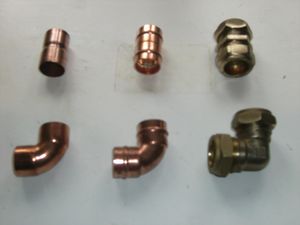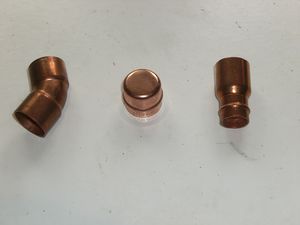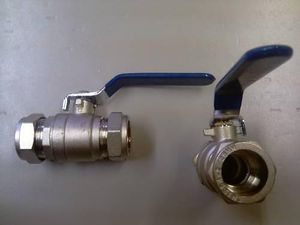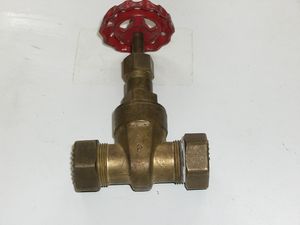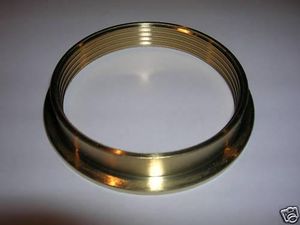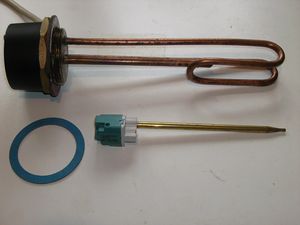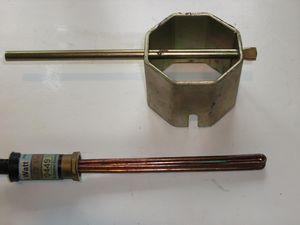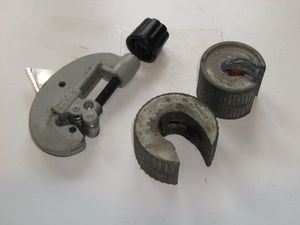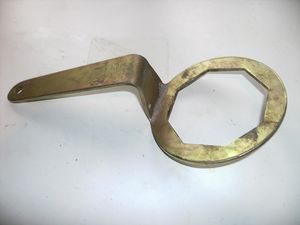Difference between revisions of "Plumbing fittings"
(→Gate valve) |
|||
| Line 1: | Line 1: | ||
| − | + | ||
<metadesc>Plumbing fittings & Tools</metadesc> | <metadesc>Plumbing fittings & Tools</metadesc> | ||
| Line 6: | Line 6: | ||
{{WIP}} | {{WIP}} | ||
| − | A brief discription of the fittings and tools used | + | A brief discription of the fittings and tools used in making a processor |
| Line 26: | Line 26: | ||
File:Fittings2.jpg |L-R 45 Regular Elbow-End feed,Stopend-solder ring,22-15 Reducer | File:Fittings2.jpg |L-R 45 Regular Elbow-End feed,Stopend-solder ring,22-15 Reducer | ||
</gallery> | </gallery> | ||
| − | + | ||
| + | Elbow | ||
An elbow is a pipe fitting installed between two lengths of pipe or tubing to allow a change of direction, usually a 90° or 45° angle, though 22.5° elbows are also made. | An elbow is a pipe fitting installed between two lengths of pipe or tubing to allow a change of direction, usually a 90° or 45° angle, though 22.5° elbows are also made. | ||
| − | Most elbows are available in short radius or long radius types | + | Most elbows are available in short radius or long radius types. |
| − | + | ||
| + | Coupler | ||
A coupling connects two pipes to each other. If the size of the pipe is not the same , the fitting may be called a reducing coupling or reducer. | A coupling connects two pipes to each other. If the size of the pipe is not the same , the fitting may be called a reducing coupling or reducer. | ||
| − | + | ||
| + | Reducer | ||
A reducer allows for a change in pipe size | A reducer allows for a change in pipe size | ||
<gallery caption="Click pictures to enlarge" widths="300px" heights="300px" perrow="2" align="center"> | <gallery caption="Click pictures to enlarge" widths="300px" heights="300px" perrow="2" align="center"> | ||
| Line 37: | Line 40: | ||
File:Fittings4.jpg |Olive (can be copper or brass),Insert-Nylon/Metal | File:Fittings4.jpg |Olive (can be copper or brass),Insert-Nylon/Metal | ||
</gallery> | </gallery> | ||
| − | + | ||
| + | Tee | ||
A tee is used to either join or split a flow. Most are tees with the same inlet and outlet sizes, but reducing tees are available as well. | A tee is used to either join or split a flow. Most are tees with the same inlet and outlet sizes, but reducing tees are available as well. | ||
| Line 127: | Line 131: | ||
* Link within this wiki here | * Link within this wiki here | ||
| − | |||
| − | |||
| − | |||
| − | |||
| − | |||
| − | |||
| − | |||
| − | |||
| − | |||
| − | |||
| − | |||
| − | |||
| − | |||
| − | |||
| − | |||
| − | |||
| − | |||
| − | |||
| − | |||
| − | |||
| − | |||
| Line 156: | Line 139: | ||
<nowiki> ... delete this "nowiki" tag once you have set your categories (it's just there to stop this section getting indexed on the main page!) | <nowiki> ... delete this "nowiki" tag once you have set your categories (it's just there to stop this section getting indexed on the main page!) | ||
| − | |||
| − | |||
[[Category:Biodiesel]] sets the main category. | [[Category:Biodiesel]] sets the main category. | ||
| − | |||
| − | |||
| − | |||
| − | |||
| − | |||
| − | |||
[[Category:Processors and equipment]] | [[Category:Processors and equipment]] | ||
| − | |||
| − | |||
| − | |||
| − | |||
| − | |||
[[Category:vegetable oil]] | [[Category:vegetable oil]] | ||
| Line 179: | Line 149: | ||
Select one from the following, and delete the others: | Select one from the following, and delete the others: | ||
| − | |||
| − | |||
[[Category:Filtration & drying equipment]] | [[Category:Filtration & drying equipment]] | ||
| − | |||
| − | |||
| − | |||
| − | |||
| − | |||
| − | |||
| − | |||
| − | |||
Revision as of 22:31, 27 August 2011
A brief discription of the fittings and tools used in making a processor
Contents
Fittings
Fittings are used in pipe and plumbing systems to connect straight pipe or tubing sections, to adapt to different sizes or shapes, and for other purposes There are basically two types of copper fittings,compression and capillary A compression fitting comprises of the body an olive and the nut,the nut is threaded onto the body of the fitting and tightened to make a leakproof connection. Fittings are typically made of brass There are two types of capillary - end feed/copper sweat and solder ring/integral ring joint
- Click pictures to enlarge
Elbow An elbow is a pipe fitting installed between two lengths of pipe or tubing to allow a change of direction, usually a 90° or 45° angle, though 22.5° elbows are also made. Most elbows are available in short radius or long radius types.
Coupler A coupling connects two pipes to each other. If the size of the pipe is not the same , the fitting may be called a reducing coupling or reducer.
Reducer A reducer allows for a change in pipe size
- Click pictures to enlarge
Tee A tee is used to either join or split a flow. Most are tees with the same inlet and outlet sizes, but reducing tees are available as well.
- Click pictures to enlarge
- Click pictures to enlarge
Valves
- Click pictures to enlarge
Ball valves
A ball valve is a valve with a spherical disc, the part of the valve which controls the flow through it. The sphere has a hole, or port, through the middle so that when the port is in line with both ends of the valve, flow will occur. When the valve is closed, the hole is perpendicular to the ends of the valve, and flow is blocked. The handle or lever will be inline with the port position letting you "see" the valve's position.
Gate valve A gate valve is a valve that opens by lifting a round or rectangular gate/wedge out of the path of the fluid.
Other
- Click pictures to enlarge
- Click pictures to enlarge
Tools
- Click pictures to enlarge
- Click pictures to enlarge
- Click pictures to enlarge
Various
Hole size required
Mechanical flange 65mm
22mm Tank connector 28mm
15mm Tank connector 22mm
You can file or drill out the "stop" on tank connectors which will allow the pipe to pass through
Pockets
You can make a pocket for a thermometer or thermocoupler by filing out the stop on a 15mm tank connector,pass a short piece of 15mm pipe through this and solder on a 15-10mm or 15-8mm reducer then solder in the required length of 8 or 10mm pipe and solder on an end cap
Second Sub-heading in second heading here
Text and photo content here ...
Delete if not required.
etc etc
End the page with the headings below...
See also
Use if there are similar pages in the wiki, if not delete.
- Link within this wiki here
- Link within this wiki here
- Link within this wiki here
Originator to sign and date here by using 4 "squiggle marks"
<nowiki> ... delete this "nowiki" tag once you have set your categories (it's just there to stop this section getting indexed on the main page!) sets the main category.
Select one from the following, and delete the others:
